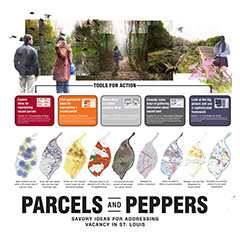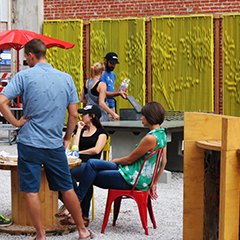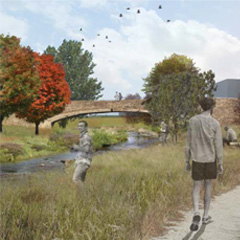April 21, 2016
Landscape architecture program receives four regional awards
Four landscape architecture projects received awards at the 2016 Central States American Society of Landscape Architecture meeting, April 15, in Little Rock, Arkansas.
Each year, the awards program honors the best in landscape architecture from the Central States region, and the student awards program gives a glimpse of the future of the profession. The Central States is comprised of six individual chapters of the American Society of Landscape Architects. These chapters come together once a year and encompass eight states including North Dakota, South Dakota, Nebraska, Iowa, Kansas, Missouri, Oklahoma and Arkansas.
The following projects received awards:
Parcels and Peppers — Excellence Award

The summer 2015 landscape architecture studio and seminar project, Parcels and Peppers strategic master plan for the city of St. Louis, led by associate professors Blake Belanger and Howard Hahn, received an Excellence Award.
Through an intense eight-week summer semester, 18 students addressed vacancy dilemmas and opportunities for the city of St. Louis. The students worked with K-State's Technical Assistance for Brownfields Communities, the Environmental Protection Agency, Department of Housing and Urban Development, and the city of St. Louis to address vacant urban property. The federal agencies are part of the White House Strong Cities, Strong Communities Initiative, which the Obama administration tasked with providing technical advice and expertise to seven cities with the intent of regaining economic footing.
Wichita Pop-Up Park — Excellence Award

The Wichita Pop-Up Park, designed and constructed by students in two classes, a graduate studio and an undergraduate materials course. The students teamed up with the Wichita Downtown Development Corporation, the Knight Foundation and a private property developer to create a pop-up park on a derelict site. Katie Kingery-Page, associate professor of landscape architecture, and Chip Winslow, professor of landscape architecture, along with Richard Thompson, instructional technologist from the College of Architecture, Planning & Design, led the effort.
The purpose of the park is to attract people to an underutilized part of downtown and provide needed amenities to downtown residents and workers. The initial program from the Wichita Downtown Development Corporation was thoughtful: a flexible use space that could be used as a food truck park and event space.
Over a yearlong period, the Master of Landscape architecture students helped plan and facilitate a stakeholder charrette; initiated a series of in-depth stakeholder interviews; developed schematic plans and design details from the charrette results; and, contributed to several features of the park through a design-build process.
Campus Creek — Honor Award

The Re-Envisioning Campus Creek project was completed by landscape architecture and biological and agricultural engineering students enrolled in the fall 2014 Specialization Studio with Jessica Canfield, assistant professor, and Tim Keane, professor.
The purpose of the project was to transform and restore Campus Creek into a resilient, multifunctional stormwater conveyance system, which serves to mitigate flooding, restore local ecosystems, and provide recreational open space in the heart of the K-State campus. Findings of the project informed development of the K-State 2015 North Campus Corridor Master Plan.
The project was sponsored by the provost's office and was completed as a gift to K-State from the landscape architecture program in honor of its 50th anniversary.
Landscape Architecture and Public Welfare — Merit Award

The Landscape Architecture and Public Welfare project was prepared by students in the Landscape Architecture Site Planning and Design studio during spring 2015 with Alpa Nawre, assistant professor, and Blake Belanger, associate professor.
The students prepared a collection of creative responses to the Council of Landscape Architectural Registration Board Foundation's call for projects to effectively communicate the vital role that landscape architects play in protecting and enhancing public welfare. The responses took the form of a children's story, short films, site design proposals and an app featuring landscape architecture.
